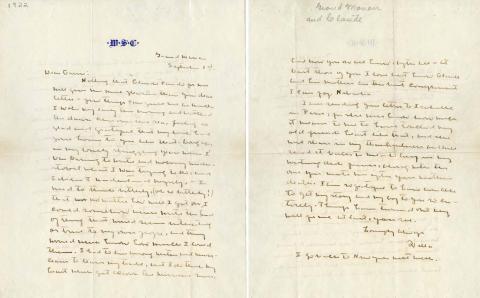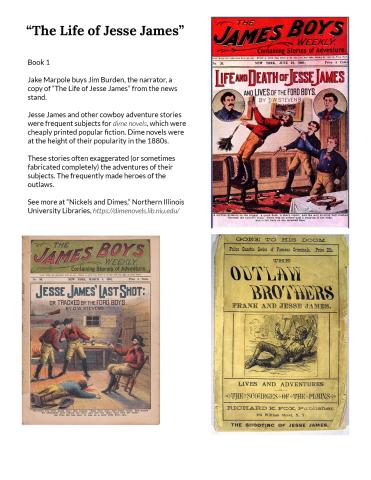
Annotations from the Archives: Teaching with Primary Sources
The collections and archives at the National Willa Cather Center have always, since our founding, played a critical role in helping our visitors gain a deeper understanding of Willa Cather. Our museum's collections rotate through our historic sites, providing context and helping readers, teachers, and students to imagine the settings of Cather’s many works set in Red Cloud. Our archival materials, from letters to photos to maps and oral histories, underpin the interpretation at our historic sites, and from the beginning, Red Cloud was an important stop for Cather researchers as they teased out Cather’s inspirations from her girlhood.
Often, however, archives are presented in popular culture as sequestered spaces, where information is guarded or, perhaps, accessible and understandable to only the few who are immersed in research. While it’s true that archives and collections are both subject to special storage conditions for their long-term preservation, the archives are open to anyone with research interest—and that includes students who might be making their very first archives visit! Our Education and Collections staff offer a number of tools to help teachers and students make the most of their Cather readings.
First, we offer several different ways to access primary source materials for the classroom. Our online collections search is a quick way for educators and students to find curated materials to accompany specific Cather works. Likewise, individual objects and records can be located using any word, date, or subject by clicking on Objects, then the Search button. On our website, we frequently feature primary source documents and museum collections pieces in this Annotations from the Archives series.
While digital archives provide amazing access to collections, we recognize that there's something special about a personal visit to the archives, where the documents of the past 150 years can be examined in close detail. Our archivist, Tracy Sanford Tucker, regularly hosts individuals and small groups for introductions to archival research, directed research project support, or more general archival research for History or English coursework. For many students, these visits comprise their first experience with archival work, so a primer on what an archivist does, as well as our policies and safe handling practices, are part of the learning process. Becoming familiar with Finding Aids is another important skill.

For younger visitors to our collections, we maintain a small teaching collection that helps to spark curiosity and engagement with museum work. Students are often asked to "Guess the Gadget" and put their decoding skills to the test in "Letter Detective" by transcribing a short note, handwritten by Willa Cather. Our Director of Education and Engagement, Rachel Olsen, can arrange for your class to take part in these activities; you can contact her at rolsen@willacather.org.

Educators can put these resources to use in myriad ways. Bellringers that use archival resources are excellent ways to jumpstart the day's activities. The "Letter Detective" exercise that we use with younger students is easy to adapt to older students and to specific Cather texts; in this example from our WCPM Collection, Cather writes to her friend Carrie Miner Sherwood about her novel One of Ours, which she refers to as "Claude" for the main character.

A similar bellringer activity involves having students spend five minutes explaining a political cartoon, an advertisement, or another visual asset to relate it to a Cather text. This cartoon, though published thirty years before My Ántonia, draws inspiration from a popular motif that Cather uses in the novel.
Many teachers use graphic organizers in their lessons, helping students identify things they Know, Want to Know, and Learned (K-W-L sheets or similar). Things that students include in the Want to Know column are great places to start with archival inquiry, and the results can take many forms! "FAQ Sheets," one such output, are single-page answers to student-generated questions; these might range from vocabulary terms to questions like "How does a threshing machine work?" The page below, related to My Ántonia, is an example of an FAQ Sheet exercise. Not only does this give students the answer they're looking for, but it gives them experience in using archival resources, lets them begin evaluating and citing sources, and encourages them to synthesize information found in two to three difference sources.

Of course, with a whole classroom generating FAQs, the next step is the development of a class zine or a student exhibit! When theater company Animal Engine created a new production called Henrietta Solway, based on Willa Cather's short story "Tommy, the Unsentimental," we developed a zine of our own, answering questions that we thought students might have. Our zine dives into the history of bicycles, how a story is adapted for the stage, and why bicycle culture was especially important to young women before the twentieth century. The zine also features archival images of Cather, words to the original music written for Henrietta Solway, and period advertisements. Students might also create a digital exhibit using a slide deck or a classroom webpage to display all of their FAQ Sheets together.

More than anything else, our archives are a place where students can discover the joy of historical inquiry, something we hope that all our visitors take away! If you would like to visit the archives to begin your own research journey—or to bring students to support teaching Cather in your classroom—please reach out to archivist Tracy Tucker at ttucker@willacather.org to schedule a time for in-person research or even a virtual visit to your classroom.
